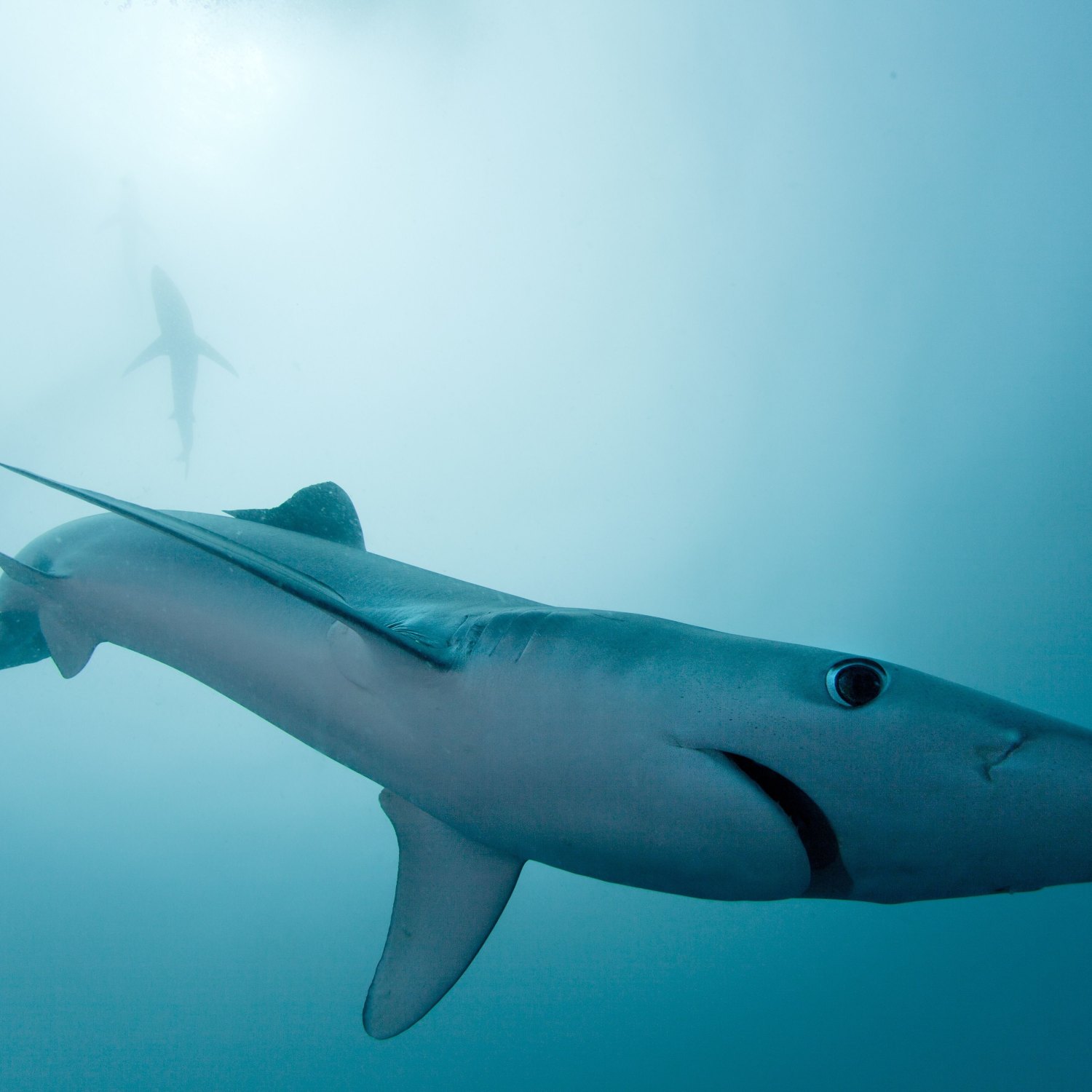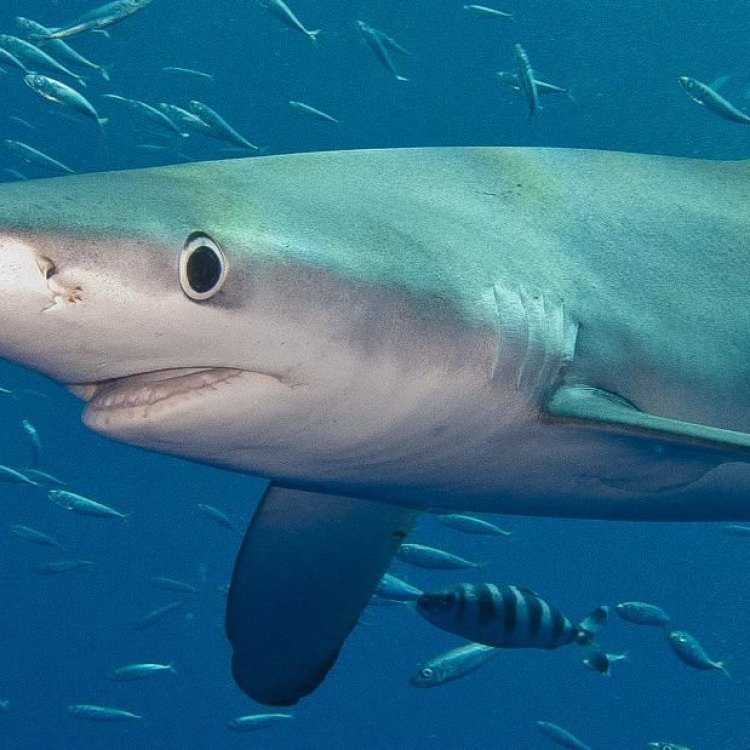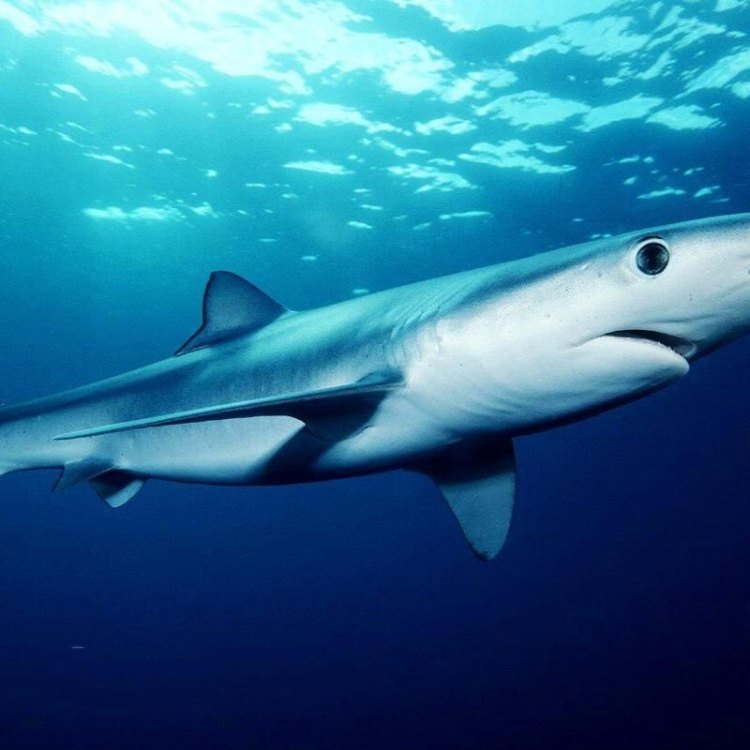
Blue Shark
Up to 11 feet
The Blue Shark, part of the Carcharhinidae family, can reach up to 11 feet in length. Known for its streamlined body and iconic blue color, it can be found in tropical and temperate waters worldwide. With its sharp teeth and impressive hunting abilities, this powerful predator is a sight to behold in its natural habitat. #BlueShark #Carcharhinidae #StreamlinedBody
Animal Details Summary:
Common Name: Blue Shark
Kingdom: Animalia
Habitat: Open ocean
The Fascinating World of the Blue Shark: Nature's Sleek Ocean Predator
The deep blue expanse of the ocean is home to a diverse range of creatures, from the tiniest plankton to the largest blue whale. One of the most fascinating creatures that inhabit this vast and mysterious world is the Blue Shark, scientifically known as Prionace glauca. With its sleek body, piercing gaze, and powerful swimming abilities, the Blue Shark is a highly adapted, fascinating predator that roams the open oceans around the globe.Evolving over millions of years, the Blue Shark belongs to the Animalia kingdom, the Chordata phylum, and the Chondrichthyes class Blue Shark. It belongs to the Carcharhinidae family and the Carcharhiniformes order, which is also known as the ground sharks. These sharks are commonly referred to as the requiem sharks, a name derived from the Latin word "requies" meaning "rest", as they are known for their slow swimming and resting behaviors.
Blue Sharks are found in the open ocean, and their range spans across the globe, making them a truly global species. However, they are absent in the freezing waters of the Arctic Ocean. These sharks have been recorded in almost all the seas and oceans, making them a truly cosmopolitan species. They are found in both tropical and temperate waters worldwide, with some hotspots being the Mediterranean Sea, the Indian Ocean, and the Pacific Ocean.
One of the most striking physical characteristics of the Blue Shark is its coloration. As the name suggests, they have a beautiful blue color which ranges from a deep steel blue on their back to a lighter blue or even white on their belly. This unique coloration allows them to blend seamlessly into their environment, making them almost invisible to their prey and potential predators Burmese. As a result, they are also known as the "wolves of the sea" due to their stealthy hunting abilities.
The body shape of the Blue Shark is another adaptation that helps them thrive in their environment. Their bodies are streamlined and tapering, with a pointed snout and elongated fins. This allows them to move quickly and effortlessly through the water, making them efficient and deadly predators. They also have a unique ability to maintain almost constant body temperature, which enables them to be active in a wide range of ocean temperatures.
Blue Sharks are carnivorous predators, and their feeding behavior is a fascinating aspect of their lives. They are opportunistic feeders and will consume almost anything that they come across. Their diet includes fish, squid, crustaceans, and even seabirds. However, their favorite food is likely to be squid, as their digestive system is best suited for digesting high quantities of squid.
The feeding method of the Blue Shark is a combination of stalking and speed. They use their highly adapted senses to detect prey, such as sight, smell, and electroreception. They can even detect faint electrical fields emitted by their prey, which helps them locate their prey even in the dark ocean depths. Once their prey is detected, they use their streamlined body to swim rapidly towards their target and attack with their powerful jaws and razor-sharp teeth.
Despite their fearsome reputation, Blue Sharks are not considered a threat to humans. In fact, they are usually shy and elusive, and their interactions with humans are scarce. However, they can become aggressive when provoked or feel threatened, so it is essential to treat them with respect and caution if encountered in the wild.
The size of the Blue Shark can vary, with males typically being larger than females. They can grow up to 11 feet in length, with some reports of even larger individuals. Females are known to give birth to live young, with litters ranging from 4 to 135 pups. The gestation period can last up to 16 months, with the pups being born fully developed and able to fend for themselves.
The Blue Shark has long been a subject of fascination for scientists, and there is still much to discover about these magnificent creatures. However, like many shark species, Blue Shark populations are facing threats from overfishing and bycatch. They are also frequently caught for their meat, fins, and oil, which are highly sought after by the shark fin soup and supplement industries. They are classified as Near Threatened on the IUCN Red List, and it is crucial to protect their populations to ensure their continued existence in our oceans.
In conclusion, Blue Sharks are truly a wonder of the ocean. They possess a range of remarkable adaptations that allow them to thrive in one of the most challenging environments on our planet. From their sleek body to their sharp senses and powerful hunting abilities, they are a true testament to the power and beauty of evolution. It is our responsibility to take care of our oceans and protect these majestic creatures so that they can continue to roam the open ocean for generations to come.

Blue Shark
Animal Details Blue Shark - Scientific Name: Prionace glauca
- Category: Animals B
- Scientific Name: Prionace glauca
- Common Name: Blue Shark
- Kingdom: Animalia
- Phylum: Chordata
- Class: Chondrichthyes
- Order: Carcharhiniformes
- Family: Carcharhinidae
- Habitat: Open ocean
- Feeding Method: Carnivorous
- Geographical Distribution: Global
- Country of Origin: All oceans except the Arctic Ocean
- Location: Tropical and temperate waters worldwide
- Animal Coloration: Steel blue on the back, fading to a lighter blue or white on the belly
- Body Shape: Streamlined and tapering
- Length: Up to 11 feet

Blue Shark
- Adult Size: Up to 11 feet
- Average Lifespan: 20 years
- Reproduction: Ovoviviparous
- Reproductive Behavior: Mating occurs through internal fertilization
- Sound or Call: No sounds or calls known
- Migration Pattern: Highly migratory
- Social Groups: Solitary or in small groups
- Behavior: Curious and agile
- Threats: Overfishing, habitat loss, bycatch
- Conservation Status: Near Threatened
- Impact on Ecosystem: Maintains balance in the marine food chain
- Human Use: Commercial fishing, sport fishing
- Distinctive Features: Long, slim body shape and large pectoral fins
- Interesting Facts: Blue sharks have a high tolerance for low oxygen levels and can swim slowly to conserve energy
- Predator: Orcas and larger sharks

Prionace glauca
The Curious and Agile Blue Shark: A Vital Ocean Creature
The vast, mysterious depths of our oceans hold an abundance of fascinating creatures. Among them is the Blue Shark, a sleek and elegant predator with a striking blue-grey hue. With its long, slender body and large pectoral fins, the Blue Shark is a remarkable sight to behold. But beyond its physical appearance, this apex predator plays a crucial role in maintaining a delicate balance in the marine ecosystem PeaceOfAnimals.Com.In this article, we will dive into the depths of the ocean to explore the unique features and behaviors of the Blue Shark. From its adult size and lifespan to its reproduction, migration patterns, and social behavior, we will uncover what makes this creature a captivating and essential part of our marine world.
The Blue Shark's Basics
The Blue Shark (Prionace glauca) is a species of shark belonging to the family Carcharhinidae. Native to the open waters of the world's tropical and temperate oceans, this shark can be found in various regions, including the Atlantic, Pacific, and Indian Oceans.One of the most distinctive physical features of the Blue Shark is its long, slim body shape, which allows it to glide effortlessly through the water. On average, this shark can grow up to 11 feet in length and weigh over 400 pounds, although reports of individuals reaching up to 12 feet have also been recorded.
A Blue Shark's lifespan is approximately 20 years, making it one of the longer-living species of sharks. However, due to overfishing and other human-related threats, their average lifespan in the wild has significantly decreased.
Reproduction and Behavior
The Blue Shark is ovoviviparous, which means they give birth to live young Blue German Shepherd. Females reach sexual maturity between 5 and 6 years, while males reach maturity between 4 and 5 years. During the breeding season, which typically occurs from June to September, male and female Blue Sharks engage in a mating ritual.Mating occurs through internal fertilization, where the male transfers sperm into the female's reproductive tract through his claspers. After a gestation period of 9-12 months, the female gives birth to a litter of 25-100 pups, depending on her size. These pups are typically 2-3 feet in length, and the mother provides no further care for them after birth.
Social Behavior and Migration Patterns
Blue Sharks are known for their curious and agile nature. They are highly migratory, covering long distances in search of food and suitable breeding grounds. These sharks can travel up to 60 miles per day, making them one of the most migratory species of sharks.They are usually solitary creatures, but have been observed to form small groups during their migration. These groups are not permanent and are formed for mating or hunting purposes. The Blue Shark's migratory patterns not only help them find food and mates, but they also play a crucial role in the ocean's balance.
Impact on Ecosystem and Human Use
The blue shark plays a vital role in the marine ecosystem, acting as an apex predator that helps maintain a balance in the food chain. As they prey on a variety of fish, crustaceans, and cephalopods, they help regulate the populations of their prey. This, in turn, prevents any one species from dominating and causing potential harm to the ecosystem.However, increased human activities have put the Blue Shark at risk. Overfishing, habitat loss, and bycatch (the unintended capture of non-target species) are some of the primary threats to this species. The International Union for Conservation of Nature (IUCN) has listed the Blue Shark as "Near Threatened" on their Red List due to its declining population.
Aside from their ecological role, humans have also been using Blue Sharks for commercial and sport fishing. These sharks are caught for their meat, fins, and other body parts, which are then sold in markets or used in traditional medicines. Their fins are particularly sought after for shark fin soup, a delicacy in some Asian countries. The demand for these fins has led to a decline in Blue Shark populations, causing significant ecological consequences.
Distinctive Features and Interesting Facts
Apart from its slender body and large pectoral fins, the Blue Shark is also known for its high tolerance for low oxygen levels. This unique adaptation allows them to swim slowly and conserve energy, making them well-suited for long-distance migrations.One interesting fact about the Blue Shark is its ability to sense magnetic fields, which helps them navigate and locate their prey in the vast ocean. In addition, contrary to popular belief, Blue Sharks are not known to make any sounds or calls.
Predators of the Blue Shark
The Blue Shark may be an apex predator, but that does not mean it is immune to threats from other creatures in the ocean. The most significant threat to adult Blue Sharks is orcas and larger shark species, such as the tiger and great white shark. The young pups are also vulnerable to predation from larger fish and other sharks, including their own species.The Importance of Protecting the Blue Shark
As we continue to explore and exploit the wonders of the ocean, it is crucial to recognize the vital role of species like the Blue Shark in maintaining a healthy ecosystem. Protecting these creatures is not only a matter of preserving their species, but also safeguarding the delicate balance of the marine world.Efforts to conserve the Blue Shark population have been made, including implementing stricter fishing regulations, creating protected areas, and educating the public on sustainable fishing practices. These measures can help reduce the threats posed to these sharks and ensure their survival.
In Conclusion
The Blue Shark may be often overlooked compared to its famous counterparts, such as the great white or tiger shark, but its beauty and significance in the ocean cannot be denied. As we continue to learn more about this species, we must also work towards protecting and preserving its population for future generations to come. Let us remember that the Blue Shark is not just a predator, but a vital and remarkable creature that contributes to the balance of our marine world.

The Fascinating World of the Blue Shark: Nature's Sleek Ocean Predator
Disclaimer: The content provided is for informational purposes only. We cannot guarantee the accuracy of the information on this page 100%. All information provided here may change without prior notice.












